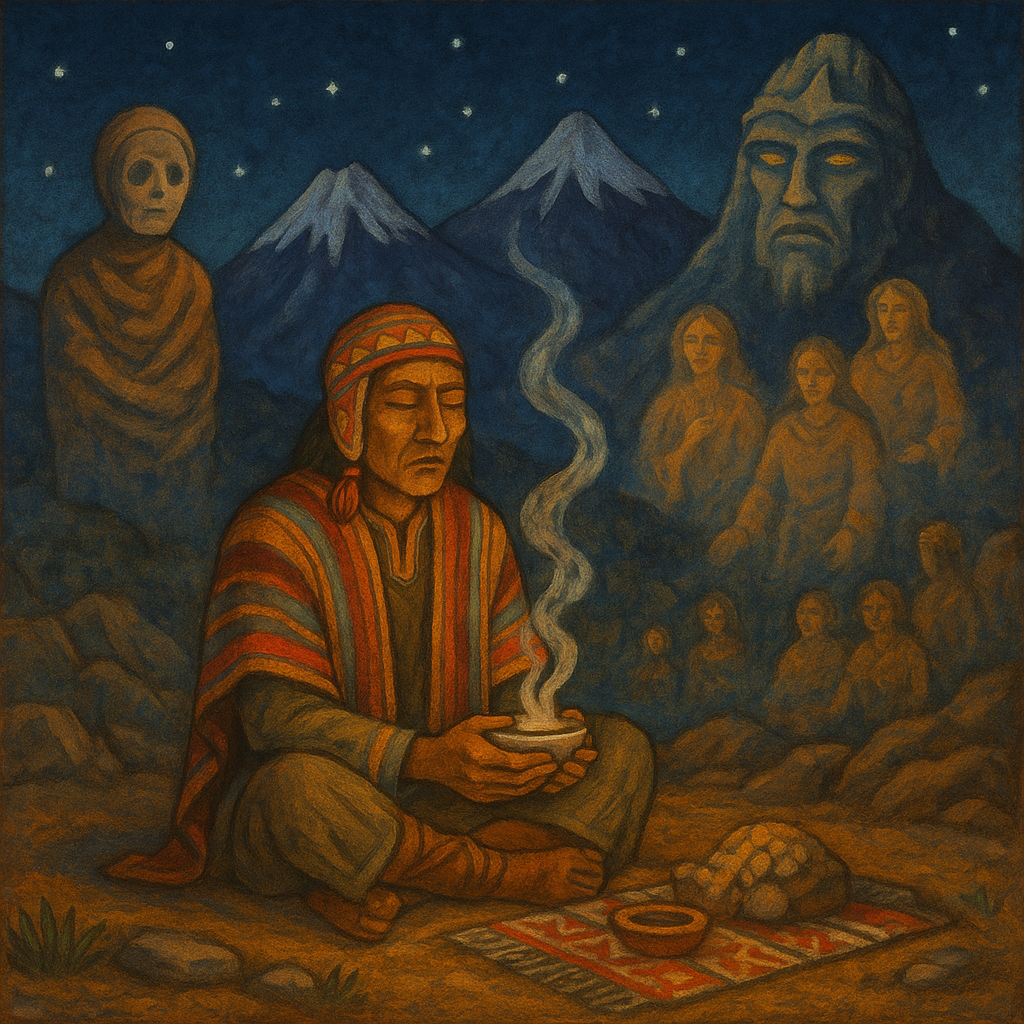Inca and Andean Beliefs: Spirit Communication, Mediumship, and Spiritual Dimensions
Introduction
The Inca civilization (c. 13th–16th centuries CE) and broader Andean spiritual traditions developed one of the most sophisticated systems of spirit communication in the pre-Columbian Americas. At the heart of their worldview was the belief that humans lived in constant dialogue with ancestors, mountain spirits, and the sacred energies of the natural world. Through ritual, trance, and mediumship, the Inca and other Andean peoples sustained harmony between the human realm and the multiple dimensions of existence.
Andean Cosmology: The Three Worlds
The Andean spiritual universe was structured into three interconnected realms:
Hanan Pacha (Upper World): The celestial realm of gods, sun, moon, stars, and heavenly ancestors.
Kay Pacha (Middle World): The human world of the living, intertwined with nature and sacred landscapes.
Uku Pacha (Lower World): The underworld of ancestors, fertility, and the hidden forces of the earth.
Together, these realms reflected a cosmic reciprocity where humans maintained balance through ritual offerings and communication with spirits.
Ancestor Communication in Inca Tradition
1. Mummies as Living Ancestors
Inca nobles and rulers were preserved as mummies (mallki), considered living beings who continued to influence political and spiritual life.
Mummies were brought out during festivals, consulted for guidance, and offered food, drink, and ritual gifts.
This practice ensured that ancestors remained active participants in governance and family affairs.
2. Household Ancestor Worship
Ordinary families maintained communication with their ancestors through household shrines.
Offerings of coca leaves, chicha (maize beer), and food were made to strengthen ancestral bonds.
Ancestors were believed to protect crops, fertility, and community wellbeing.
Mediumship and Andean Shamans
1. Altomisayuq and Pampamisayuq
In Andean tradition, shamans or ritual specialists called altomisayuq (high priests) and pampamisayuq (earth priests) served as mediums between humans and the spiritual world.
They entered trance states through drumming, chanting, or coca rituals to channel messages from spirits.
2. Trance and Spirit Possession
During ceremonies, shamans acted as vessels for apus (mountain spirits), ancestors, or deities, speaking with voices and messages beyond their own.
Mediumship was a sacred responsibility used for healing, divination, and community protection.
3. Divination and Coca Leaves
Coca leaf reading (k’intu) was a central method of communication with spirits.
By observing patterns and interpreting the arrangement of leaves, shamans conveyed messages from gods, ancestors, or the natural world.
Spiritual Beings and Dimensions of Contact
Apus (Mountain Spirits): Majestic mountains were considered living beings and powerful guardians. People offered coca, llamas, and ritual libations to maintain their favor.
Pachamama (Earth Mother): The great Earth deity who nourished and sustained all life. Offerings were made through pago a la tierra (earth payments) to ensure fertility and balance.
Mallki (Ancestors): The spirits of the dead, embodied in mummies and shrines, who guided and protected.
Inti and Mama Quilla: The Sun and Moon deities, central to ritual calendars and agricultural cycles.
Ukhu Spirits: Entities of the inner earth, linked with fertility and hidden power, contacted through ritual.
Ritual Practices and Spirit Communication
Offerings (Despachos): Ritual bundles of food, coca leaves, and symbolic items burned or buried to communicate with spirits.
Pilgrimages: Sacred journeys to mountains, springs, and caves where contact with spirits was strongest.
Festivals: Ceremonies like Inti Raymi (Festival of the Sun) brought entire communities into communion with divine and ancestral powers.
Oracles and Shrines (Huacas): Sacred sites where priests acted as mediums for deities or ancestors, delivering prophetic messages.
Comparisons with Western Mediumship
Similarities: Trance mediumship, ancestor communication, ritual offerings, and divination.
Differences: Inca and Andean practices were communal and state-centered, with rulers and shamans mediating for the entire community. Mediumship focused on fertility, agriculture, and cosmic balance, rather than personal afterlife evidence.
Continuity and Modern Legacy
Andean spiritual traditions remain vibrant today:
Pago a la tierra (earth offerings) to Pachamama are still widely practiced in Peru and Bolivia.
Shamans continue to serve as mediums for apus and ancestors in rural communities.
Festivals like Inti Raymi celebrate cosmic cycles and spirit communication.
Modern Andean spirituality blends Inca traditions with Catholicism, yet maintains strong continuity in ritual practice.
Conclusion
The Inca and broader Andean peoples developed a rich system of spirit communication, mediumship, and multidimensional cosmology, ensuring harmony between humans, ancestors, and nature. Through mummy veneration, shamanic trance, coca divination, and offerings to Pachamama and apus, the Andean worldview created an enduring dialogue with the unseen.
Unlike Western Spiritualism, Inca traditions emphasized cosmic reciprocity, community wellbeing, and the sacredness of landscape, embedding mediumship into every aspect of life.

